P.A. Wilson's Blog, page 30
May 16, 2012
Review of Best Exotic Marigold Hotel
I just saw The Best Exotic Marigold Hotel with my mother. A matinee so the experience was flavored with that feeling of playing hookie, and it’s a sunny and warm day, so a taste of ‘we should be playing outside’ added to it.
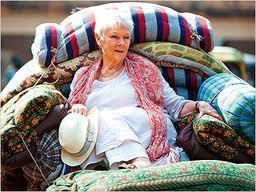
It’s a movie about a group of British seniors who for one reason or another – mostly because it’s affordable – respond to an advertisement for a luxury hotel in India for the elderly and beautiful. Of course when they arrive, all is not what it was advertized to be.
The movie follows them through their adventures in trying to fit in and find a way to enjoy their final years. The culture and tradition of India touches all of them whether or not they want it to.
The review
I knew that the story would be good. The actors were familiar faces from all kinds of other British ensemble movies. What made me enjoy the story so much was the way all the characters were treated with respect. This was a story about all the people in the movie, not just Dame Judy or Bill Nighy. The fun was shared between the arguing couple, the randy singles and the young lovers.
India was used as a character in itself. Not disinfected to appeal to the Western sensibility or overly dramatized as a country of poverty and riches. There was beauty and joy and poverty and dirt – what more could you want.
What was the overriding emotion?
The feeling of hope. That it is never too late to start living the life you want. That before anything happens you must have a dream. The contrast between the traditional treatment of the elderly in some countries and the love and respect that Sonny feels towards his guests. After all, everything will be fine in the end, so if it’s not fine, it must not be the end.
Tear jerk factor
I’m not a big crier in movies and when I do cry, I’m often left with the feeling that I’ve been forced to cry. This movie has it’s moments, and I’m sure there were a few sobs in the theater. I had a little tightening of the throat and dampness behind my eyes, but it was a real reaction.
The bottom line
My mother hasn’t been to a movie since Indiana Jones and the Last Crusade. Something about the movie made her want to see it – and, maybe her latent rebelliousness about going to a movie in the middle of a sunny day. Having seen this one, she wants to go again. We’re on the lookout for our next matinee experience.
May 14, 2012
Developing a new story in a series
I’m getting ready to write the third book in the Quinn Larson series and unlike some writers I only have a bit of an idea what will happen in each story. I do know the bigger story, but not the details. So I pretty much start from scratch each time.
So where do I start?
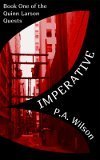
I usually start by thinking about my characters, the hero – Quinn – and the Villain and how they get in each others way to entertain you.
There are lots of other characters, I hope you love them all, but the key to the story is how the two main characters conflict.
This book has been flitting around my brain for a while and I couldn’t quite pin down what was going to happen.
How did I overcome it?
The good news is anyone can find a way to overcome a block. I found help in the way I usually do, I talked it out with writer buddies.
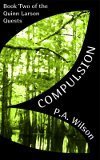
Tonight I tossed the problem to my buddies in our Waves Coffee write in. I told them my process, my problem and then we tossed around ideas until I had the epiphanies that I needed.
Why is this important?
I think a book is a collaboration of ideas. Even when I have a book worked out in my mind, asking writers for input always gives me a deeper understanding or a new twist on the idea.
I do this at all stages of the book. When I think the first draft is complete, I ask for input on the story. I need to know if there’s anything missing – usually setting – or if I’ve padded something. I get readers to give me feedback before I do the final polish. And I listen to reviews after the book is published.
Listening to reviews helps me craft better stories in the future. So, I value every review I get, good or bad.
May 13, 2012
The New Normal gets redesigned cover
 “She’s not my friend.”
“She’s not my friend.”
Madeline left her old life behind when she chose to stay in the magical world of Cartref. Here, she has a husband, a home, and her arcane studies. Somehow, working as a lawyer just doesn’t appeal anymore.
That life hasn’t quite let her go, however.
It seems that she is not the only one to be summoned from Earth. By chance, her old nemesis from the law firm has been snatched through the veils between the realms, and she’s landed in the hands of a people known as the Choi. At first, Madeline suspects it was one of her own spells gone awry, but it becomes clear that the Choi have their own, very dark schemes in mind. Madeline can’t let a former enemy, even one as utterly frustrating as Lee Marshall, become a sacrifice in a brutal blood magic ritual.
Nevertheless, the Choi face extinction without it. Their leader, Skye Greatmother, has bet the future of her people on the blood power of a strange woman from a foreign land. For their tribe to live, someone has to die, and if Madeline can’t figure out another way, it’s going to be Lee – or Madeline herself.
When the sun rises, and the ritual magic takes hold, the blood must flow.
May 12, 2012
Are Vampires becoming less frightening?
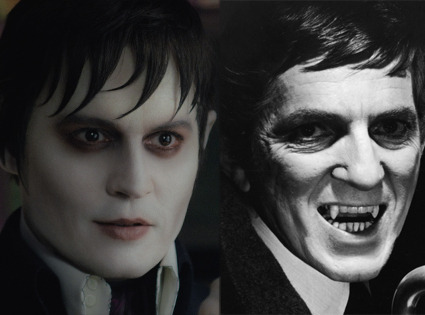 The soon to release Dark Shadows by Tim Burton got me thinking about Vampires. Why have we taken something that was terrifying and turned it into something non-threatening, or even silly?
The soon to release Dark Shadows by Tim Burton got me thinking about Vampires. Why have we taken something that was terrifying and turned it into something non-threatening, or even silly?
The background
I occasionally watched Dark Shadows when I was young, but what I remember the most, was the series of books. I would start reading one and If I didn’t remember to put it down before I went to bed, I was trapped reading until morning.
I saw Lost Boys and I read Salem’s Lot. All of them gave me the creeps. I think it was the inevitable fear of the math – one Vampire could turn everyone, eventually.
I stopped reading about Vampires, and didn’t even get into the Buffy series.
What I see as the current state of Vampires
Well, there’s a lot of buzz about sparkly vampires and I have to say I try to stay out of it. I don’t think I should shout out an opinion on something I haven’t read and I don’t want to read the Twilight series. I’m not in it’s target audience and that’s fine. But Dark Shadows – no I haven’t seen it yet but I probably will. I love Tim Burton and Johnny Depp. The trailer is a bit disconcerting for me. I can’t see this Barnabas keeping me awake. He’s too human. He’s a fish out of water. He’s not relevant.
Why no Vampires in the Quinn Larson Quests?
Well, for both reasons.
I like to fill my stories with a rich mixture of creatures. I believe if this magical world exists, it would hold all the creatures we know from our legends. But, I couldn’t find a way to include the evil seductive kind, or the sparkly self sacrificing kind.
The original kind of Vampire would have taken over the story. The new Vampire just didn’t ring true for me. I couldn’t just ignore them either, so I made them a lesson. If the humans defeated and obliterated Vampires, it would make the humans a real threat.
The bottom line
I still like a good Vampire story – one that has a bloodsucking variety that doesn’t much care about humans. I just can’t bring myself to put them in a book as a secondary character. If they go into a story , they take it over and they don’t much care what happens to the other characters as long as they can get some food.
May 10, 2012
Off Track gets a new cover.

Off Track gets a new cover for Amazon and Smashwords.
A LAWYER IN A STRANGE LAND
Madeline’s always had a purpose. Lately, it’s been to make partner at her high-powered law firm, something that she’s chased relentlessly for years, even to the exclusion of a social life and any solid relationships.
Fate, and some pretty powerful magic, change all of that in minutes.
She and her assistant Simon are pulled into another world, where magic and prophecy are real. The people of the Summer Lands are under threat from a blood feud between their ruler, Lord Alric, and the demented warmonger Sayer Goddard. It can only end when one family is destroyed – and Alric has been assassinated, leaving the realm without a leader and open to ransacking by Goddard.
It seems that all hope is already lost with the death of Alric’s line. It has been foretold, however, that Madeline will play a part in what will save them – even if she’s not exactly willing to get involved at all.
Alric’s wife and the current ruler, Lady Arabela, is pregnant with his son. She needs Madeline’s help to finally kill Goddard and end the blood feud, but no one – not even Madeline herself – knows exactly what she’s supposed to do.
Time is already running short. Their quest to stop Goddard has to be done by the next full moon, or the land will be overrun and destroyed. Arabela is not used to taking no for an answer, especially not with her subjects’ lives as stake. But Madeline’s not used to being so completely off-track, and she doesn’t take orders from anyone – not even someone with magic and an army at their disposal.
Today, however, is anything but usual. Today, the life or death of a nation rests with her.
Is there a right price for an ebook, is it higher for a traditionally published author?
If you are tired of the ongoing discussion about the agency pricing issue, maybe you n eed to decide for yourself, agency agreement or not, what you’ll pay for an ebook.
eed to decide for yourself, agency agreement or not, what you’ll pay for an ebook.
The problem
If you haven’t heard about the issue, here’s a quick sketch of it. Traditional Publishers (the big 6) and Apple are being accused of price fixing ebooks. The idea is by making the ebook expensive -sometimes more than the paperback – they can slow down the market for ebooks. Why? Well according to their calculations they can’t make a profit on cheap ebooks. The thing is, Amazon gives them a higher royalty cut if they price between $2.99 and $9.99 so they can make more money at lower prices.
How did we get here?
It all started with agency pricing. A great idea that allowed the publisher, or author set the price of an ebook. The great idea went south when the big 6 decided that meant they could keep the price high.
Why does it matter?
Here’s the thing, when you buy a physical book, it’s yours. When you buy an ebook, it’s kind of yours. Even without DRM (mine are DRM free), it’s still hosted on a the retailer’s server. That means it can disappear. In that light, why would you pay more for an ebook than a paperback?
Why would you buy an ebook in that case?
Everyone has their own answer to this. Mine is, I can carry a whole bunch of books with me for the weight of my phone, or my Kindle.
What can you do?
I like the idea of voting with your wallet. I have decided that I’m not paying more than $10 for an ebook no matter how much I like the author. And, dear big 6, I won’t buy the paperback instead. Like many people who adopted ebooks, I don’t buy physical books any longer – well unless it’s a beautiful cookbook that I got through a class at Barbra Jo’s - so you don’t get a sale.
But Indie authors are crap!
That’s not true. Neither is the flip side. If the traditional route was perfect, every traditionally published book would be a best seller.
Yes, there are people who are putting up work that needs to be edited and proofread. But, a lot of us are getting that done. A lot of us cringe when we hear of an error. And, unlike a traditional publisher, a lot of us make the corrections when they are pointed out.
The bottom line
Think about it when you buy an ebook for more than the price of a paperback (I’ve seen them as more than the price of the hardcover). If you keep paying inflated prices, you validate the policy.
May 8, 2012
Does it feel like war between the indie and the traditional publisher?
If you follow the discussion on blogs and forums, you can be forgiven for thinking that the Traditional Publishing houses are the Death Star and the Indie publishers are the intrepid rebels. I think that’s not the right model.
Another view
I read an interview with John Locke on Indie Reader today that I think brings a better picture into focus.  John says,
John says,
“Before entering into my distribution deal with Simon & Schuster, I knew that TV and print media was the exclusive domain of traditionally-published authors. I knew as an indie author it was unlikely I would ever be interviewed on TV, or have my paperback, Wish List, reviewed in print media. So I knew there was an exclusive club. But I thought my distribution deal made me a member, or at the very least, an honorary member. Boy, was I wrong! I hired a publicist and offered myself up…and quickly learned I was not part of the club! Not one media outlet would talk to me or review my book. Even the little papers in the towns where I grew up and went to high school and college refused to do a story on me!”
Read the full interview here
My take on it
I didn’t go the indie route because I hate the traditional publishers. I do feel like they need to shift focus from hanging on to a broken model to exploiting the new opportunities. And, like John, I think there are lots of opportunities. Building bridges can help both paths to publication thrive.
As an indie author, I tried the ‘I DO IT’ method and it became clear that I didn’t have some basic skills outside of crafting a good story (I hope). Now, I go looking for people who have the skills, and who I can afford, and who see me as a valuable client. I’ve been lucky – and patient – to find people I can work with. That means, there’s value to the traditional model because I’m doing it in a small way.
In my post about writing for your audience, I offered the opinion that the author going the traditional route has to write their story twice. Once for the agent/publisher and once for the reader. I think in an ideal world, the gatekeeper would be a concierge rather than a funnel. For the savvy Indie author there are lots of people who can give you the value that a traditional agent/author would provide.
The bottom line
For me, I think the two different paths to a reader will co-exist. Like a lot of change, it will take some pain, but I think we’ll make it. Remember not every indie publisher is delivering unedited crap to the table. And, every book from a traditional house is not a best seller. There’s common ground between the two poles.
May 6, 2012
Book review, The Unfortunate Miss Fortunes
When she was sixteen, Dee Fortune kidnapped her two younger sisters and ran from danger. Now, twenty-nine, she’s still trying to control her shape-shifting power — no easy task when Danny James shows up one Friday morning with his deadly smile and dangerous questions about the past.
Lizzie is determined to save her family from financial ruin by turning straw into gold; now, if she could only stop turning forks into bunnies. Then Elric, a sorcerer, appears one Friday — annoyed with the chaos Lizzie is creating in the universe and his heart…
The youngest Miss Fortune, Mare, towers above her sisters but her telekinetic power is dwarfed by their gifts. She spends her days at Value Video!! and her nights contemplating the futility of her existence. But then a gorgeous Value Video!! VP and Mare’s long-lost love turn up…and they all turn up the heat on a weekend that no Fortune will soon forget
What did I enjoy the most?
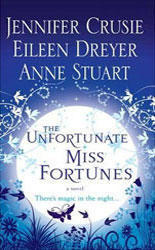
I liked the way the characters felt like family. The main story was fun and the romances were hot and believable. The sisters were different from each other in the way real sisters are, but fiercely loyal when it came down to the crisis.
What did I learn from the book?
I learned about tying together three stories so that they seem like one. The main story is about the magic and the crisis with the aunt, but each sister has her own story. Each wants a different future and each feels differently about their magic.
I would be tempted to treat each sister as a sub-plot, but that wouldn’t have done justice to the characters. The three authors found a way to weave 4 plots together and include a couple of fun subplots along the way.
I’m embarking the journey of writing a series of romances that need to be separate stories but have a common thread. Reading this book has given me some ideas about how to keep the four stories alive without weakening the main romance of each book.
The bottom line
I love Jennifer Crusie and now I will be buying some ebooks from Anne Stuart and Eileen Dreyer. I recommend any of these authors to readers who want some humor and some sizzle with their romance.
May 4, 2012
Creating fictional places, how much is needed to get it right?
I’m starting to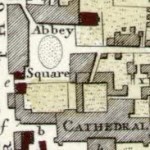 write a romance series.
write a romance series.
One of the key parts of the story is a small town where the action takes place. In my other novels I have needed general sketches of the environment and some floor plans. For this town – as yet unnamed – I need details. It’s almost a character of the book. So I did some searching and came up with these steps from eHow. I’m going to give you my thoughts on how I’ll fare.
Getting ready
Okay I think we can assume I can get graph paper, a pencil and a marker together. It says a fine tipped black marker, but I’m going off the play book and will use colors.
Steps 1-3. There’s hope that they all come together
I’m including some of the pre-step 1 information here because it all feels the same. Draw a rough outline in pencil, begin to fill in more details.
I’m looking for a town so I’ll keep it into a rough rectangle or square. I’ll leave lots of room for countryside. Here’s where I think I’ll need the eraser – and a big one. I have problems thinking through things like cross streets and intersections and how they relate to each other.
Pencil is good – eraser is better.
Step 4 and 7 – Naming places
Well, I’m told I have an knack for names so I think if I make it to here, I’ll be fine. I already have a name for one of the buildings. I’m thinking churches and diners and stores are going to be more fun than effort.
Step 5 and 6 – Making it more permanent
This sounds simple. I just have to use the marker(s) to go over the pencil lines. So, assuming I haven’t erased a hole or two in the paper, you would think I would be cruising here. Not necessarily, I get cocky. I need to marshal my patience and even stick my tongue out of the side of my mouth to focus myself.
If it works for children I’m willing to try it.
Lessons I learned in thinking this through
Here’s the point. Drawing isn’t my thing, but I’m the one with the details in my head. The only way I can know if it works is to give it a try. For a writer, it’s not just about getting words on a page. To make your story feel real, you need to deal with the details. Not only do you need to know the plot and characters, you need to know the intimate details of the place and time.
You may never use 90% of the information you gather, but if you don’t know it, you’ll make a mistake that your readers will catch. I learned this as I was writing Off Track. At one point I had Madeline wandering around the house and she managed to walk a corridor that couldn’t be there because I’d described the view from the windows of the room. I quickly sketched out a layout of the house to make sure I didn’t forget that kind of detail again.
Now the map is thought through – next step the romance.
May 2, 2012
Who do you write for? Is there a difference between the indie and the traditional author?
 This will probably get me into trouble, but I’ve been thinking and observing and I believe independent authors write differently from the author who is or is seeking traditional publishing.
This will probably get me into trouble, but I’ve been thinking and observing and I believe independent authors write differently from the author who is or is seeking traditional publishing.
A quick definition of the difference between the two routes.
Traditional publishing means the author writes the best book they can and they submit queries to agents/publishers and they get their offer (yeah I know it’s not that easy). And then they work with the editor to make the book more marketable.
The indie author writes the best book they can and then publishes it.
Marketing is a whole different ballgame. I’m offering a guest post if you want to talk about that.
The traditional route
I have friends who are focused on the traditional route of publishing and I watch them as they craft and revise and gather feedback and revise (okay that’s what we all do). Because they are trying to get through that gatekeeper (the agent/publisher) they are writing for that audience. Their book starts out as a product to sell to an intermediary. If they can craft the best first page, the best first chapter, the best… well, whatever. They will win the prize of a deal, the rewriting begins. The book now has to become something that will sell to the reader.
From the first idea to the book appearing for sale can be five years. From acceptance by a publisher to available for sale can be 2 years.
The independent route
Indies still write the best book they can and I’m telling you that’s hard work no matter how you approach publishing. Then they publish the book – some pay for help, some just put it up. They have written the book for their reader and now they want to get it in the hands of that fan.
From the first idea to the book appearing for sale is highly variable. I can take a book from idea to publish in as little as 4 months but I usually have a book scheduled for publishing every 6 months.
How would you choose which one works best for you?
I’m not sure it’s as simple as making a choice. One thing about most indie authors I know is their need for control. We like to do our own thing and we like to experiment and we like to break rules. We can do that because we don’t have a weight of tradition behind us.
The people I know who are interested in the traditional path believe there is value in the professional advice they get. They like the advances (who wouldn’t). And they see the history of success traditional publishing can bring to the table.
My conclusion
I am not saying either route is the best – it all depends on the author. If my interpretation is correct, the time it takes to rewrite your book to a new audience and then fit into a marketing schedule means you as the reader have to wait longer for your next read.
So, is this going to get me into trouble? Is there going to be controversy? Are people going to disagree? I hope so. I think healthy debate is good. It opens people’s minds to new ideas. It can change the world.



